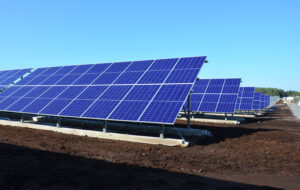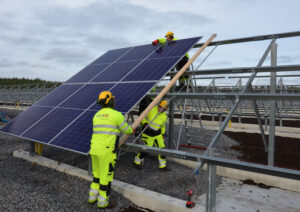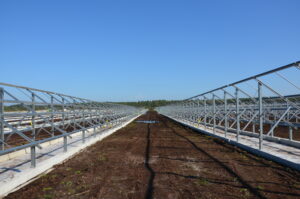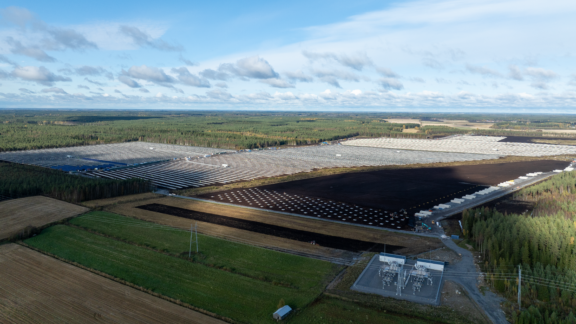EPV Energy’s first industrial-scale solar power park is currently being built in Heinineva, Lapua. The park, which will be completed at the end of 2025, will have approximately 123,000 panels installed and will cover an area of about 120 hectares. Thus, the Heinineva park will be one of the largest in Finland and the first solar power park built on a former peat production area.
The scale of the solar power park is significant, which has required a considerable amount of planning and research work even before construction began. An essential part of the preparation has been to consider responsibility issues at various stages of the project and to ensure their implementation in practice. Responsibility issues have been taken into account, for example, in the monitoring of supply chains, occupational safety, and the management of permit and environmental matters.
Component supply chains are closely monitored
The panels and their mounts to be installed in the Heinineva solar power park are manufactured in China. China is currently the leading country in solar power technology, and production on a similar scale is not found elsewhere in the world.
EPV has monitored the quality and traceability of supply chains with the help of an external consultant. Ari Soininen, Managing Director of EPV Aurinkovoima, states that local consultants hired by EPV visited the factory manufacturing the Heinineva panels and mounts for the first time during the selection of the panel supplier.
The consulting work has been carried out by Sinovoltaics, an internationally leading verification entity in the solar power industry.
“The consultants prepared an ESG report after visiting the factory. The report included, among other things, aspects that the panel supplier needed to improve in their production processes before starting production. Additionally, the factory has been extensively examined for environmental and safety issues,” says Soininen.
Reporting and regular inspections have continued even after the start of production. The monitoring of production has paid special attention to the quality and origin of the raw materials used in the panels. Traceability aims to determine, for example, from which part of China the raw materials used in the panels originate. The origin of the raw materials is verified through documentation.
According to Soininen, the purpose of the reporting and monitoring work is to ensure that EPV’s required responsibility standards are met in production and supply chains according to the agreements.
“The agreements stipulate that raw materials or other components must not come from certain geographical areas. If there are deficiencies or issues in traceability, we will reject the respective delivery batch,” Soininen mentions.

Attention to occupational safety
The Heinineva park area is an exceptionally large entity, requiring special organization of construction work and movement. Raimo Wegelius, the site manager of EPV Aurinkovoima, states that extensive studies were conducted on working at the site even before construction began.
“The first phases included preparing a rescue plan and a risk assessment. After these were completed, we also held meetings with rescue authorities. For organizing construction work, we have drawn good practices from other EPV production methods, such as wind power,” Wegelius explains.
New employees and visitors first go through site orientation before entering the area. The orientation introduces them to the site’s safety instructions and practices.
Wegelius mentions that the implementation of instructions and practices is monitored through weekly occupational safety rounds in the park area. Representatives from the contractor and EPV participate in these rounds.
“During the occupational safety round, the entire site is reviewed, followed by a meeting on the observations made. If more critical observations are noted during the round, they are discussed in the meeting with all parties involved. We aim to correct the identified deficiencies as quickly as possible,” Wegelius says.
Significant local employment impacts
The construction of the solar power park is managed by Suvic Force, a subsidiary of Suvic Oy, which employs approximately 120 workers during the construction and installation phases at Heinineva. The solar power project has significant local employment impacts, as the workers mainly come from the Lapua-Kauhava-Seinäjoki area.
The majority of the workers are of foreign background. The workers represent about twenty different nationalities, various genders, and age and language groups. Despite the diverse backgrounds of the workers, they are united by high work motivation and a desire to continuously learn new things, according to Suvic’s HSEQ managers Eetu Pajala and Matteus Markko.
“We assign suitable tasks to each worker based on their physical capacity and interests. Site-specific orientation is provided by supervisors before starting work, and we are present in the field to monitor and assist the workers as needed,” says Markko.
Pajala and Markko estimate that about 80–90 percent of the foreign workers speak English. Therefore, all materials have been translated into English, and the instructions utilize visualizations of work phases with images to facilitate learning. Workers who speak English translate the instructions for those in their language group who speak their native language.
“The implementation of the instructions in practical work has been excellent. We want to commend the workers for consistently using protective equipment, which shows that they have truly internalized the instructions they received,” says Markko.
The Nordic work culture, which emphasizes open dialogue, was unfamiliar to many workers. Pajala explains that from the beginning, the importance of open communication between workers and supervisors has been emphasized, and all feedback has been welcomed.
“In terms of occupational safety, we have stressed that it is important to report all observations preventively so that we can further improve our instructions and daily operations. Open communication is also promoted through weekly safety briefings for workers, where current issues are discussed, and workers can highlight areas for improvement they have noticed on the site,” he mentions.
According to Pajala, many workers have found a new direction in their careers in the solar power industry through the project, and their cooperation with Suvic is likely to continue in the future.
“Thanks to the Heinineva project, the workers have become true experts in solar power construction. Many workers have already expressed their desire to continue with us after the construction work is completed and have inquired about when they can start working on the next park projects,” Pajala explains.

Peat bog transforms into solar power park
The Heinineva area was previously used for peat production and served as an energy peat production area for EPV’s power plants for over 20 years. Previously, the Heinineva area and its peat production environmental permit were under the control of EPV Aluevarannot.
Peat production at Heinineva ended in August 2021, after which the area entered a two-year aftercare phase. During the aftercare phase, the area was cleaned of peat production structures, and load and water monitoring continued in accordance with environmental permit requirements. The environmental permit for peat production and the related obligations ended in October 2023, as approved by the environmental permit requirements and the ELY Centre.
“Since the end of peat production, the area has been prepared for solar power construction. Some water management structures have been retained, which can also be utilized for solar power needs,” says Menna Luhtala, EPV’s Regional Development Manager.
For construction work, a planning requirement decision was initially sought for the area, followed by the application for building permits from the city of Lapua. A drainage notification was made to the ELY Centre regarding the change of drainage conditions from open ditches to controlled subsurface drainage, which helps manage both the load from the area and carbon dioxide emissions. Additionally, a water law permit was required from the Regional State Administrative Agency due to potentially acidic sulfate soils.
The Heinineva project supports a clean transition
Luhtala explains that peat production areas are typically flat, extensive, and shadow-free, creating favorable conditions for solar power production. Therefore, at Heinineva, there was no need to clear trees for the park.
EPV also plans to build its future solar power parks on former peat production bogs in Ostrobothnia and South Ostrobothnia. Valuable information and experience from the ongoing Heinineva project will be used for future solar park projects.
According to Luhtala, it can already be stated that the reuse of a former peat production area in the form of solar power has proven to be the right solution. She says that EPV is also doing significant pioneering work in the field of solar power construction.
“Heinineva has already been an energy production area with no significant natural values or environmental risks. Therefore, it has been favorable for establishing solar power production. The Heinineva solar power project concretely supports the transition to clean and renewable energy production.”

For more information contact: Ari Soininen, Managing Director of EPV Aurinkovoima, +358 50 3862 523

